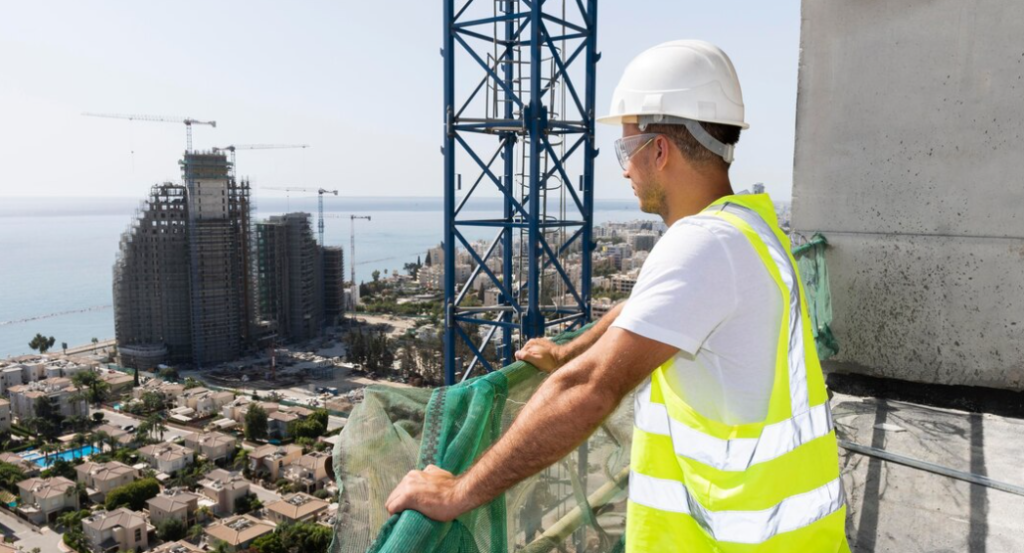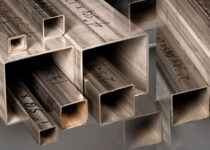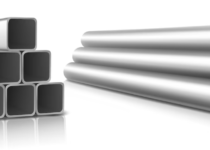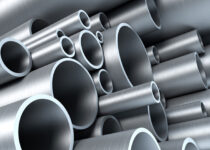Steel Scaffolding Safety Standards in Dubai UAE: Ensuring Construction Safety

Steel Scaffolding Safety Standards in Dubai UAE: Dubai, United Arab Emirates, a thriving hub of architectural marvels and construction wonders, has been setting new benchmarks in skyscraper development and infrastructure innovation. Central to this progress is the rigorous adherence to steel scaffolding safety standards—a fundamental aspect of construction that ensures worker safety and project integrity. In this blog, we’ll discuss in detail the comprehensive safety standards, regulations, case studies, and success stories pertaining to steel scaffolding in Dubai, UAE.
Understanding the Significance of Steel Scaffolding Safety
Importance of Steel Scaffolding Safety Standards
Steel scaffolding serves as the backbone of construction, offering support, access, and safety to workers. Spar Steel Industries manufactures and supplies different steel scaffoldings like Cuplock Systems, Pipes and Tubes, Tube and Fittings, Caster Wheel, Scaffold Steel Board Plank, Ladder Beams and Lattice Beams. In Dubai, where ambitious skyscrapers and intricate structures adorn the skyline, the significance of maintaining stringent safety standards cannot be overstated. These standards are implemented to mitigate accidents, ensuring the well-being of workers and the structural integrity of the projects.
Dubai’s Emphasis on Safety of Steel Scaffolding
The Emirate of Dubai has been steadfast in its commitment to fostering a safe working environment at different construction sites. The Dubai Municipality, the regulatory body overseeing construction, has laid down comprehensive safety standards, codes, and regulations are discussed below to govern steel scaffolding practices.
Steel Scaffolding Safety Standards in Dubai UAE

Dubai Municipality Regulations for Scaffolding Safety
The Dubai Municipality has established a set of guidelines, legal requirements and regulations for ensuring steel scaffolding safety standards . These encompass specifications for material quality, erection procedures, load-bearing capacities, regular inspections, and adherence to international safety standards such as Occupational Safety and Health Administration (OSHA) guidelines. In addition, the following steel scaffolding legal requirements in Dubai, UAE are:
- Thrakhees-Dubai-U.A.E and Scaffolding Regulations: Thrakhees, an entity in Dubai, U.A.E, has established its own set of legal requirements in relation to scaffolding practices.
- Scaffold Legal Requirements under Dubai Multi Commodities Centre (DMCC): The DMCC in Dubai has its distinct legal requirements concerning scaffolding to ensure safety and compliance within the industry.
- Legal Requirements of Dubai Development Authority (DDA) for Scaffolding: The Dubai Development Authority (DDA) in Dubai, UAE, has set forth its legal prerequisites related to scaffolding within the construction domain.
Dubai Municipality’s Code of Construction Safety Practice (COP)
The Dubai Municipality has introduced the “Code of Construction Safety Practice (COP)” to regulate steel scaffolding safety standards across all activities within the emirate. Specifically, Chapter 8 of the COP focuses on “Scaffolding Safety,” outlining legal requirements pertinent to scaffolding practices in Dubai. Some of these essential requirements are detailed below:
- Supervision and Execution: The erection, movement, dismantling, or alteration of scaffolds must be overseen by competent individuals and executed by skilled, experienced workers.
- Structural Integrity: Every scaffold and its components must be capable of supporting their weight. Additionally, they should withstand a load at least four times the maximum intended load they’ll bear or transmit.
- Distance from Power Lines: Scaffolds must not be erected or used within 3 meters (10 feet) of energized power lines to prevent any potential contact between scaffold components and these power lines.
- Supported Scaffold Ratio and Ties: Supported scaffolds with a height to base width ratio exceeding four to one (4:1) require vertical and horizontal ties to the building structure. The first bottom tie should be positioned no higher than four times the minimum base width. Furthermore, vertical ties should be placed at intervals not exceeding 8 meters (26 feet), while horizontal ties should be maintained at each end and at intervals not exceeding 9 meters (30 feet).
- Third-Party Inspection: All supported and suspended scaffolds necessitate inspection by a third party approved by the Dubai Municipality. This inspection should result in the issuance of a valid certificate by the inspecting company.
These requirements, as outlined in Chapter 8 of the COP, ensure the strict adherence to safety standards in steel scaffolding practices, contributing to a safer work environment and the overall safety of construction activities in Dubai, UAE.
Training and Certification to Ensure Steel Scaffolding Safety Standard
Workers involved in steel scaffolding are required to undergo specialized training and certification programs. These programs ensure that individuals are well-versed in safety protocols, installation techniques, and the proper use of safety equipment.
Case Studies Illustrating Safety Standards Implementation
Case Study 1: Burj Khalifa Construction
The iconic Burj Khalifa, the world’s tallest building, stands as a testament to Dubai’s commitment to safety. The construction of this monumental structure meticulously adhered to stringent safety standards for steel scaffolding. Through the implementation of regular safety audits, comprehensive safety training, and the use of cutting-edge equipment, the project achieved an exemplary safety record, ensuring zero fatalities related to steel scaffolding.
Case Study 2: Dubai Metro Construction
The Dubai Metro, a testament to modern infrastructure, followed rigorous safety standards for steel scaffolding. The project implemented innovative safety measures, including the use of advanced materials, real-time monitoring systems, and strict adherence to safety guidelines. As a result, the project not only met its completion deadline but also maintained an impeccable safety record, safeguarding the lives of workers involved.
Future Outlook for Ensuring Steel Scaffolding Safety Standards in Dubai
Dubai’s commitment to safety standards in steel scaffolding is not just a legal requirement but a moral imperative. The case studies discussed illustrate the pivotal role that adherence to safety standards plays in ensuring the well-being of workers and the successful completion of ambitious projects.
As Dubai, UAE, continues its march toward architectural brilliance, maintaining and improving steel scaffolding safety standards will remain a cornerstone of the construction industry. Spar Steel Industries in UAE follows all regulations and uses different international and local safety standards like ASTM, API, BS, EN, ESMA, in manufacturing and supplying different steel scaffolding products in Dubai (UAE), Middle East,and other MENA countries. Through continual innovation, education, and a collective commitment to safety, the city will uphold its reputation as a global leader in construction while ensuring the safety and security of its workforce
Conclusion
In conclusion, the amalgamation of stringent regulations, proactive measures, and a collective commitment to steel scaffolding safety will serve as the bedrock for Dubai’s construction industry. The case studies underscore the significance of these safety standards, reinforcing Dubai’s position as a paragon of construction safety excellence in steel scaffolding practices.
It’s imperative to understand that while Dubai has made significant strides in safety, the commitment to continual improvement and innovation in steel scaffolding products manufacturing is essential for sustained progress. As the construction landscape evolves, so too must the safety standards, ensuring that workers and projects are safeguarded, thereby solidifying Dubai’s position as a beacon of safety in construction practices.
FAQ on Steel Scaffolding Safety Standards in Dubai UAE
Q. What are the specific safety standards for steel scaffolding in Dubai UAE?
Ans. In Dubai, UAE, steel scaffolding safety standards are governed by the Dubai Municipality’s regulations, which outline detailed guidelines on design, installation, and usage. Adhering to these standards ensures that scaffolding structures meet the highest safety criteria in construction projects.
Q. Why is it crucial to comply with steel scaffolding safety standards in Dubai?
Ans. Compliance with steel scaffolding safety standards in Dubai is paramount to ensure the well-being of construction workers and the overall safety of construction sites. Adhering to these standards mitigates the risk of accidents, enhances structural stability, and contributes to a safer working environment.
Q. How often should steel scaffolding be inspected to meet safety standards in Dubai?
Ans. Regular inspections are imperative to maintain safety standards. In Dubai, UAE, steel scaffolding must be inspected before initial use, at least once a week during use, and after any event that could affect its structural integrity. Following a rigorous inspection schedule helps identify potential issues promptly, preventing accidents.
Q. Are there specific training requirements for workers using steel scaffolding in Dubai?
Ans. Yes, there are. Workers involved in the assembly, disassembly, and use of steel scaffolding in Dubai must undergo specialized training programs. These programs cover safety protocols, proper handling techniques, and emergency procedures. Ensuring that workers are well-trained enhances overall site safety.
Q. Can modifications be made to steel scaffolding while ensuring compliance with safety standards in Dubai?
Ans. Modifications to steel scaffolding in Dubai are allowed only if they are approved by a competent person and in accordance with the manufacturer’s specifications. Any unauthorized alterations compromise safety standards and may lead to accidents. It is crucial to follow proper procedures and seek approval before making any modifications.
Q. How does Dubai enforce steel scaffolding safety standards, and what are the penalties for non-compliance?
Ans. Dubai’s regulatory authorities conduct regular inspections to ensure compliance with steel scaffolding safety standards. Non-compliance can result in penalties, site shutdowns, or legal actions. To avoid such consequences, it is essential for construction companies and workers to stay informed about and strictly adhere to the established safety standards.
Q. What type of scaffoldings are used in the UAE?
Ans. In the UAE, a commonly used type of scaffolding products are Single Scaffolding, Double Scaffolding, Cantilever Scaffolding, Cantilever Scaffolding, Suspended Scaffolding, and as per specific need.
Q. What are scaffolding standards?
Ans. Scaffolding standards encompass regulations and guidelines defining the safe design, construction, and use of scaffolding structures. As OSHA scaffolding standard ensures a competent scaffolding expert is one who is capable of identifying existing and predictable hazards in the surroundings or working place of a construction site. The expert sensures compliance with safety measures, promoting a secure working environment in construction.




